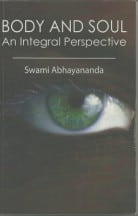 Body and Soul – An Integral Perspective by Swami Abhayananda, whose books and articles may be read and freely downloaded on his website at: www.themysticsvision.weebly.com, he has graciously allowed us to offer them here as well.
Body and Soul – An Integral Perspective by Swami Abhayananda, whose books and articles may be read and freely downloaded on his website at: www.themysticsvision.weebly.com, he has graciously allowed us to offer them here as well.
Throughout history, the dualistic approcah to Reality have been given innumerable names, such as Purusha and Prakrti, Brahman and Maya, Shiva and Shakti, Jahveh and Chokmah, Theos and Logos, Tao and Teh, Dharmakaya and Samsara, Haqq and Khalq, and on and on.
This classic dualism between Soul, or spirit, and the matter-producing Energy has not only been the conventional Eastern metaphysical view; it has been the conventional Western metaphysical view as well, from the time of Pythagoras and Plato, on through the Neoplatonists, Hermetics, and Jews, carried forward by Christianity and Islam, and reaffirmed analytically in the seventeenth century by René Descartes.
Swami Abhayananda proposes a framework for an integral perspective. Download his book (275 pages) here:
 Body and Soul – An Integral Perspective
Body and Soul – An Integral Perspective
What is dualism in metaphysics?
Dualism in metaphysics is a philosophical concept that posits the existence of two distinct and irreducible substances or principles that make up reality. These substances are typically understood as fundamentally different, often contrasting in terms of their properties and characteristics. The most common form of dualism is mind-body dualism, which proposes that the mind and the body are two separate and distinct substances.
Body and Soul dualism, famously articulated by René Descartes, suggests that the mind (or consciousness) and the body are separate entities. According to this view, the mind is non-physical or immaterial, while the body is physical. This leads to questions about how the mind and body interact, given their distinct natures.
Another well-known example of dualism is substance dualism, which asserts that there are two kinds of substances in the universe: mental substances and physical substances. Mental substances encompass thoughts, feelings, consciousness, and other mental phenomena, while physical substances include everything in the material world.
Criticism about Dualism
Dualism has faced criticism and challenges over the years, largely due to the difficulty of explaining how these distinct substances interact. This issue is known as the mind-body problem. Critics argue that the interaction between the immaterial mind and the physical body is not easily reconciled with our understanding of the natural world and the principles of causality.
In contrast to dualism, monism asserts that there is only one fundamental substance or principle that makes up reality. Monism can take different forms, such as materialism (which asserts that everything is fundamentally physical) or idealism (which asserts that everything is fundamentally mental or consciousness-based).
It’s important to note that dualism comes in various forms and has been debated extensively in philosophy. The concept of dualism extends beyond just the mind-body distinction and can apply to other aspects of reality as well.

